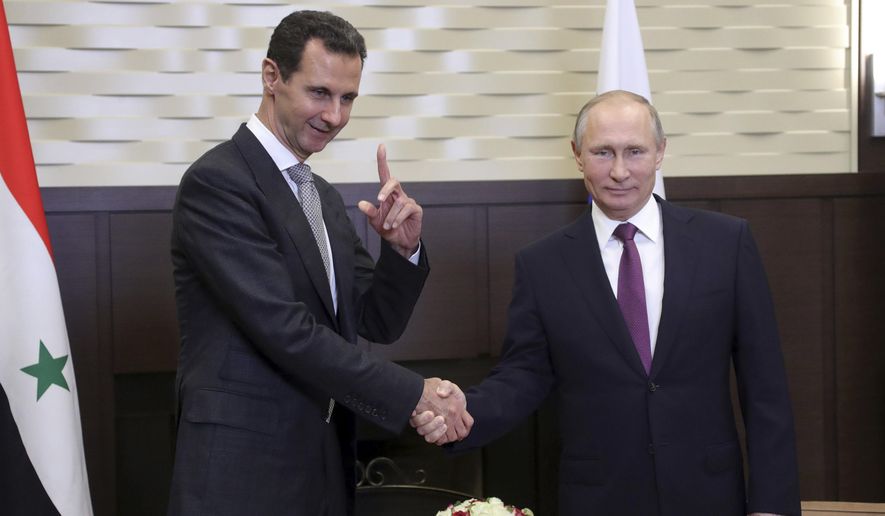MOSCOW (AP) - Meeting with Syrian President Bashar Assad this week, Russia’s President Vladimir Putin said recent successes in battling the Islamic State group in Syria have allowed for a shift in focus to a political settlement for the war-torn country.
But while Putin also said that his military campaign in Syria is wrapping up, he gave no indication that Russia would scale down its military presence in Syria - something Moscow is unlikely to do.
Here are some key moments in Russia’s military campaign in Syria:
RAPID RESPONSE
A series of defeats suffered by Assad’s army in 2015 left his government teetering on the brink of collapse, prompting the Kremlin to intervene militarily to protect its long-time ally.
Weeks after Moscow signed a deal with the Syrian government on August 26, 2015 to deploy its forces, the Russian military refurbished the Hemeimeem air base in Syria’s province of Latakia to prepare it for hosting dozens of Russian warplanes.
The operation dubbed “the Syrian Express” saw the delivery of thousands of tons of military equipment and supplies by sea and heavy-lift cargo planes.
The following month, on Sept. 30, Moscow declared the launch of its air campaign in Syria, Russia’s first military action outside the former Soviet Union since its 1991 collapse.
___
STANDOFF WITH TURKEY
The Russian military campaign angered Syria’s neighbor Turkey, which has pushed for Assad’s ouster and backed Syrian opposition forces since the start of the conflict in 2011.
On Nov. 24, 2015, a Turkish fighter jet shot down a Russian warplane on the border with Syria. The plane’s pilot was killed by Turkey-backed Syrian opposition fighters as he parachuted from his jet, and a Russian marine was also killed during an operation to rescue the second pilot. Turkey said the Russian plane violated its airspace, a claim that Moscow denied.
Infuriated by Turkey’s action, which he described as a “stab in the back,” Putin unleashed an array of crippling economic sanctions, including a ban on the sales of tour packages to Turkey, a freeze on Turkish construction business in Russia and imports of Turkish fruit and vegetables. The Russian military also quickly beefed up its air defenses in Syria with the long-range S-400 missiles to force Turkey to back off.
___
SIGNIFICANT BATTLES
In April 2016, Assad’s forces, relying on Russian air support, scored a major symbolic victory by taking the ancient town of Palmyra from the Islamic State group. Russian army engineers cleared the world-famous archaeological site of mines and celebrated the victory with a concert on site by the St. Petersburg Mariinsky orchestra.
In December 2016, the Syrian army again lost Palmyra to IS and it took Assad’s forces until March to recapture it.
Also in December, the Syrian army recaptured the rebel-held eastern part of Aleppo. The city - Syria’s largest and once its commercial hub - had been carved up into government- and rebel-controlled parts since 2012. The fall of eastern Aleppo demoralized the rebels and deprived them of the largest urban area under their control. Assad’s victory followed ferocious battles, in which thousands died, and left the rebel enclave in ruins. After the fall, Russia deployed hundreds of military police to patrol the city’s eastern part.
Under Russian air cover, Assad’s army and Iranian-backed militiamen have also pushed into the energy-rich eastern Syria region over the past weeks, driving the Islamic State group from its last strongholds including the town of Boukamal over the weekend.
___
BOOTS ON THE GROUND
While most attention has been on Russian airstrikes, Russia has also been actively involved in ground operations. Senior Russian military officers helped train and direct Syrian government troops, while Russian special forces conducted intelligence and coordinated airstrikes.
Russia never said how many troops it has in Syria, but turnout figures in voting from abroad in the September 2016 parliamentary elections indicated that Russian military personnel in the Arab nation at the time likely exceeded 4,300.
Russia has lost 39 servicemen in Syria so far, according to official data. Russian news reports indicated that a number of contractors for private Russian security companies also have been killed in action, but their deaths have not been officially confirmed.
___
SYRIA BATTLEFIELD TESTS
The Syrian war provided an arena for Russia’s military to test its new weapons in real combat, including state-of-the art Kalibr cruise missiles launched by Russian strategic bombers, navy surface warships and submarines. The long-range precision-strike cruise missiles have given a major boost to Russia’s military capability.
In another first, Russia’s sole aircraft carrier, the Admiral Kuznetsov, sailed to the Eastern Mediterranean last fall to launch the first carrier-borne combat missions in Russia’s navy history, during the months-long battle over Aleppo.
Other weapons that made their combat debut in Syria included the Su-34 and the Su-35 warplanes, and the Mi-28 and the Ka-52 helicopter gunships.
___
MEDIATION BY RUSSIA, TURKEY AND IRAN
Faced with massive damage from Russia’s economic sanctions, Turkish President Recep Tayyip Erdogan moved to mend ties, offering apologies for downing the Russian warplane. Putin responded by strongly backing Erdogan during a failed military coup in Turkey.
Since then, the two leaders have held regular meetings and phone talks to narrow their gap on Syria. Iran has joined Russia and Turkey in trying to negotiate a settlement.
Together, Russia, Turkey and Iran have brokered several rounds of Syria peace talks in Kazakhstan’s capital, Astana. The meetings - separate from the U.N.-backed Syria peace talks in Geneva - brought the Syrian government and rebel groups face-to-face.
The three powers also have negotiated a deal on so-called “de-escalation zones” in Syria, which have helped reduce hostilities and were welcomed by the U.N.




Please read our comment policy before commenting.